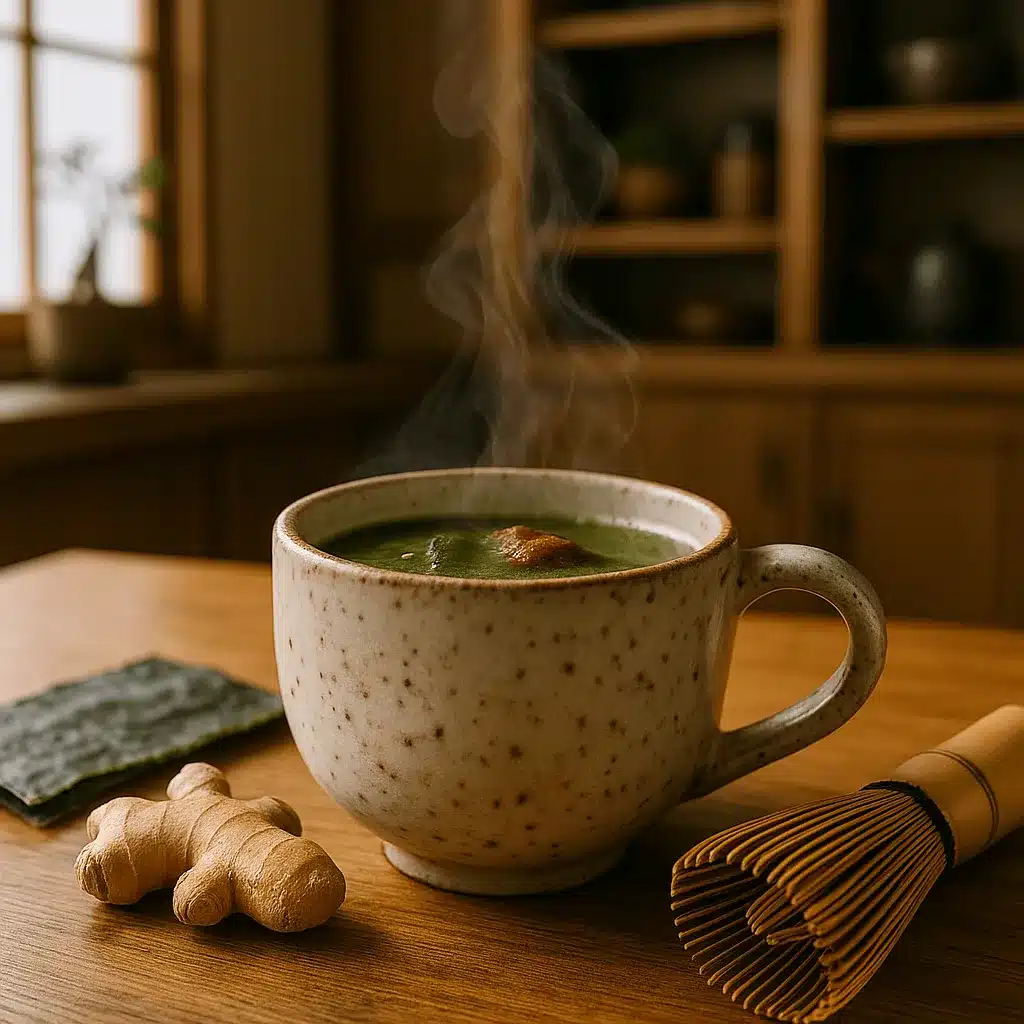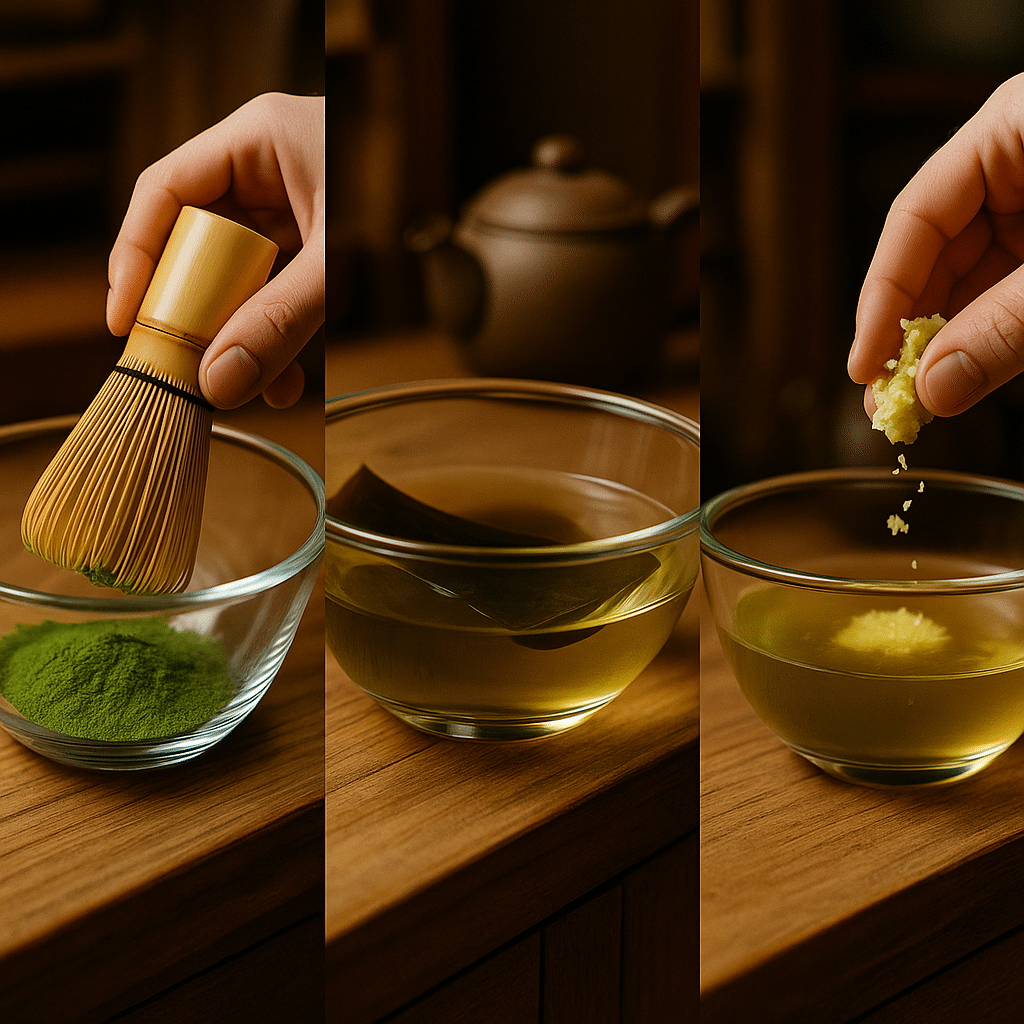Japanese Mounjaro Tea changed everything for me one hectic Tuesday morning.
I was juggling a client call, packing school lunches, and reheating last night’s chicken thighs—when I realized I’d skipped breakfast again. Sound familiar?
That’s when I remembered a calming, energizing drink I’d been testing in my home kitchen—a warming blend of matcha, ginger, kombu, and umeboshi. It wasn’t coffee. It wasn’t just tea. It was a recipe rooted in tradition and designed to do more than wake you up—it supported digestion, boosted energy, and helped manage cravings without that 3 p.m. crash.

I’m Brooklyn Taylor, and for over a decade, I’ve helped busy people—just like you—make simple, high-protein meals that taste like comfort food without the guilt. My kitchen is where crispy chicken dinners meet cozy, nourishing sips. And lately? This natural tea has been my not-so-secret weapon for staying balanced and energized.
Whether you’re chasing kids, clocking overtime, or just trying to eat a little better without overhauling your life, this guide to Japanese Mounjaro Tea is for you.
It’s one of the most effective natural detox drinks used daily in Japan.
Table of Contents
Table of Contents
The Rise of Japanese Mounjaro Tea in Wellness Culture
What is Japanese Mounjaro Tea?
Forget pills and fads. Japanese Mounjaro Tea is a natural detox drink inspired by centuries of Japanese wellness traditions. It’s not to be confused with the weight loss drug Mounjaro—instead, it’s a holistic blend of real ingredients like:
- Matcha green tea for antioxidants and gentle caffeine
- Umeboshi plum for digestion and detox
- Fresh ginger for metabolism and immunity
- Kombu (kelp) for essential minerals and thyroid support
When combined in warm water, these ingredients create a light, savory-sour tea that naturally curbs cravings, reduces bloating, and energizes without the jitters. It’s especially powerful when sipped in the morning or after meals—just like many people in Japan do as part of their daily routine.
Origins in Traditional Japanese Herbal Practices
What makes Japanese Mounjaro Tea more than just a trendy blend? Its roots go deep into traditional Japanese food wisdom, where ingredients like kombu and umeboshi have been used for generations to keep the gut healthy and the body in balance.
From matcha ceremonies to miso broths, Japanese culture has long understood that food is medicine. This tea brings that philosophy into a single, simple cup—an intentional ritual that soothes the gut, supports the metabolism, and fuels a calm, clear mind.
If you’re someone who enjoys food that nourishes body and soul, this tea fits right in with cozy weeknight soups and hearty chicken meals. It’s not a replacement for good food—but it is the perfect warm-up act.
Full Recipe Card: japanese mounjaro tea recipe

Japanese Mounjaro Tea
Ingredients
- 1 teaspoon matcha powder (good quality if possible)
- 1 umeboshi plum (or about 1 teaspoon umeboshi paste)
- 1 slice fresh ginger, finely grated
- 1 small piece dried kombu (thumb-sized)
- 8 ounces warm water (around 160–170°F)
- Optional: splash of lemon juice or drizzle of honey
Instructions
- Grate the ginger, measure the matcha, and prepare the kombu.
- Heat water to 160–170°F, not boiling.
- Steep the kombu in the warm water for 5 minutes.
- In a separate bowl, whisk the matcha powder with a splash of warm water until frothy.
- Remove kombu from the water.
- Stir in the umeboshi, grated ginger, and frothy matcha into the kombu water.
- Adjust flavor with lemon juice or honey if desired.
Notes
Nutrition
Key Ingredients Behind Japanese Mounjaro Tea
Matcha: A Caffeine-Controlled Metabolism Booster
At the heart of Japanese Mounjaro Tea is matcha, the bright green, finely powdered tea leaf that’s been used for centuries in Japan’s tea ceremonies. But this isn’t just about tradition—matcha offers real benefits:
- Sustained energy: Matcha contains L-theanine, which helps calm your mind while the natural caffeine gives a clean lift—no spikes, no crashes.
- Metabolism support: Rich in EGCG (a potent antioxidant), matcha gently boosts thermogenesis, helping your body burn calories more efficiently.
- Detoxification: Because you consume the whole leaf, matcha provides chlorophyll, which supports liver detox and cellular health.
If coffee makes you jittery or anxious, matcha is your new best friend. It gives you focus without the crash—and when paired with ginger and kelp, it creates a wellness powerhouse.
Kombu and Umeboshi: The Gut-Healing Seaweed and Plum Duo
These two might sound exotic—but they’re foundational to Japanese food culture and the secret to this tea’s gut-friendly magic.
Kombu (kelp):
- A type of sea vegetable rich in iodine, essential for proper thyroid function and metabolism regulation.
- Contains fucoidan, a unique compound that supports immune function and cellular repair.
- Adds a natural umami flavor to the tea, creating that savory base that’s both soothing and satisfying.
Umeboshi plum:
- A fermented plum known for its sharp, salty-sour taste and digestive benefits.
- Helps with post-meal bloating and acts as a natural anti-bacterial, especially for the gut.
- Full of alkaline minerals, which support pH balance and overall detoxification.
Together, kombu and umeboshi work to rebalance your gut, help with sluggish digestion, and keep your energy steady throughout the day.
Natural Mounjaro Recipe Variations and Global Fusion
Japanese Mounjaro Recipe for Weight Loss
The classic Japanese Mounjaro Tea isn’t just flavorful—it’s functional. The traditional recipe is carefully crafted to promote weight management, improved digestion, and natural energy.
Here’s the most authentic version:
Traditional Japanese Mounjaro Tea Recipe
| Ingredient | Amount | Purpose |
|---|---|---|
| Matcha powder | 1 tsp | Boosts metabolism, provides antioxidants |
| Umeboshi plum or paste | 1 plum or 1 tsp paste | Supports digestion, adds savory-sour flavor |
| Fresh ginger (grated) | 1 slice or ½ tsp | Anti-inflammatory, curbs cravings |
| Kombu (kelp) | 1 thumb-sized piece | Provides iodine for thyroid health |
| Warm water (160-170°F) | 8 oz | Steep base and activate ingredients |
Optional Add-ins:
- A squeeze of lemon (for brightness)
- A drizzle of raw honey (if you like a touch of sweet)
- Chia seeds or yuzu zest (for texture and zing)
Preparation (No-fuss & fast):
- Steep kombu in warm water for 5 minutes
- In a separate bowl, whisk matcha with a splash of warm water
- Remove kombu, stir in umeboshi, ginger, and matcha
- Add honey or lemon juice if desired
- Sip slowly, preferably before breakfast
This blend doesn’t just rev up your metabolism—it helps calm the digestive tract, supports thyroid balance, and keeps you full longer. A morning cup of this is like telling your body, “We’ve got your back today.”
Natural Mounjaro Tea vs. Brazilian Mounjaro Drink
Now, let’s compare the Japanese Mounjaro Tea with the Natural Mounjaro version popularized in Brazil and the U.S.
Natural Mounjaro Recipe
| Ingredient | Role |
|---|---|
| Apple cider vinegar (1 tbsp) | Fat-burning, detox support |
| Lemon juice (½ lemon) | Vitamin C, aids digestion |
| Fresh ginger (½ tsp grated) | Metabolism boost |
| Raw honey (1 tsp, optional) | Balances tartness |
This version skips matcha and kombu but still delivers craving control and fat-burning support, especially when taken first thing in the morning. It’s simple, plant-based, and ideal for beginners looking for a low-cost alternative.
Compare it with the:
Brazilian Mounjaro (3 Ingredients)
- Brewed green tea
- Lemon or lime juice
- Grated ginger
This variation is caffeine-based like the Japanese version, but lighter in flavor and easier to make in bulk. It’s perfect for those who want a cold, refreshing version in summer.
| Feature | Japanese Mounjaro | Natural Mounjaro | Brazilian Mounjaro |
|---|---|---|---|
| Base | Matcha + Kombu | ACV + Lemon | Green Tea |
| Flavor | Savory-sour | Tart-spicy | Citrus-refreshing |
| Function | Gut health, thyroid, metabolism | Detox, cravings | Fat burn, hydration |
| Best Time | Morning or after meals | Morning on empty stomach | Before meals |
How Japanese Mounjaro Tea Supports Weight Loss Naturally
Thermogenesis and Craving Control via Ginger and Matcha
One of the most powerful weight loss features of Japanese Mounjaro Tea lies in its natural ability to activate thermogenesis—a fancy word for how your body burns calories to produce heat. This happens thanks to two key ingredients:
- Ginger: A known thermogenic food, ginger helps raise body temperature slightly, stimulating calorie burn even while you’re at rest. It’s also shown to reduce appetite and support fat oxidation—meaning it helps your body use fat for fuel.
- Matcha: This vibrant green powder brings the magic of EGCG (epigallocatechin gallate), a potent antioxidant that boosts metabolism. Unlike caffeine from coffee, matcha also contains L-theanine, which provides calm focus and prevents jittery crashes.
Together, this duo gently revs up your system and helps you stay fuller longer—naturally reducing the urge to snack without relying on harsh stimulants.
Iodine and Digestive Support for Thyroid Regulation
Another standout feature of Japanese Mounjaro Tea is its ability to support thyroid health and gut function—two systems deeply tied to metabolism and weight balance.
Kombu’s Contribution:
Kombu, a mineral-rich kelp, is an excellent source of iodine. Iodine is a critical nutrient for the thyroid gland, which controls how your body uses energy. When your thyroid is underactive (a common issue among people with stubborn weight), metabolism slows and weight gain follows.
By drinking a small dose of kombu-infused tea daily, you’re offering your body a gentle, food-based way to keep that thyroid humming along smoothly.
Umeboshi’s Superpower:
This fermented plum supports gut health by:
- Aiding digestion after meals
- Reducing bloating and water retention
- Promoting alkaline balance, which many experts believe is helpful for long-term weight maintenance
Add in warm water, and you’ve got a soothing elixir that’s as functional as it is flavorful.
Why It Works Long-Term (Not Just for a Week)
Unlike crash diets or stimulant-heavy fat burners, the benefits of Japanese Mounjaro Tea are designed to accumulate over time. When consumed consistently, here’s what many users report:
| Benefit | Effect |
|---|---|
| Less bloating | Thanks to improved digestion |
| Fewer cravings | From steady blood sugar and appetite balance |
| Increased energy | Without caffeine crashes |
| Easier fat burning | Due to mild thermogenesis and metabolism activation |
| Gentle detox | With matcha, umeboshi, and lemon helping flush the system |
It’s not magic—but it is metabolic maintenance, and when paired with a high-protein, whole-food diet, it becomes a powerful ally in your wellness toolkit.
How to Prepare Japanese Mounjaro Tea at Home

Traditional Recipe Step-by-Step
Making Japanese Mounjaro Tea at home is surprisingly simple, and the best part? You probably already have many of the ingredients in your pantry.
Here’s how to make the traditional version that’s been loved in Japan for generations.
Ingredients for Japanese Mounjaro Tea:
| Ingredient | Amount | Purpose |
|---|---|---|
| Matcha powder | 1 tsp | Energy, antioxidants, metabolism boost |
| Umeboshi plum or paste | 1 plum or 1 tsp | Digestion support, alkalizing |
| Fresh ginger (grated) | 1 slice or ½ tsp | Thermogenic, anti-inflammatory |
| Kombu (kelp) | 1 thumb-sized piece | Iodine, gut support |
| Warm water | 8 oz at 160–170°F | Activates ingredients, safe steeping |
Instructions:
- Heat the water: Don’t boil—aim for 160–170°F (hot but not steaming). This preserves nutrients in kombu and matcha.
- Soak the kombu: Let the kombu sit in the warm water for 5 minutes to release its minerals.
- Whisk the matcha: In a separate small bowl, combine matcha with a splash of the warm water and whisk until frothy.
- Remove kombu: Take out the kombu from the steeping water.
- Mix it all: Add the umeboshi plum, grated ginger, and whisked matcha into the water. Stir gently.
- Customize (Optional): Add a splash of lemon juice or a tiny bit of raw honey for balance.
You can sip it warm in the morning, or chill it and pour over ice for a refreshing midday pick-me-up.
Easy Modern Variations Using Local Ingredients
We get it—sometimes, you just need a version that fits what you have on hand. Here are a few flexible adaptations you can make without losing the core health benefits.
| Substitution | Use Instead | Why It Works |
|---|---|---|
| No kombu? | Nori seaweed or skip it | You’ll lose some iodine, but flavor remains |
| No umeboshi? | Pinch of sea salt + lemon juice | Mimics the sour-salty balance |
| No matcha? | Green tea bag | Lower in antioxidants but still effective |
| Prefer sweet? | Add raw honey or stevia | Natural sweetness without blood sugar spikes |
| Sensitive to caffeine? | Halve the matcha | Still get benefits with less buzz |
These smart substitutions ensure that Japanese Mounjaro Tea remains approachable no matter where you are or what you have on hand. The goal is balance, not perfection.
When and How to Drink Japanese Mounjaro Tea for Best Results
Morning Detox or Evening Calm? Timing Matters
To get the full spectrum of benefits from Japanese Mounjaro Tea, when you drink it is just as important as how you prepare it.
Here’s the breakdown:
| Time of Day | Benefit | Why It Works |
|---|---|---|
| Morning (before breakfast) | Metabolism jumpstart | Matcha and ginger help fire up your body’s fat-burning furnace |
| Mid-morning (between meals) | Craving control | Keeps blood sugar stable and reduces snacking |
| Before lunch or dinner | Digestion support | Umeboshi and ginger stimulate digestive enzymes |
| Late afternoon | Energy without caffeine crash | Matcha offers a smoother lift than coffee |
| Evening (low-caffeine version) | Gut reset, gentle detox | Use half-matcha or caffeine-free green tea alternative |
Most people report the best results when they sip their first cup of Japanese Mounjaro Tea 30 minutes before breakfast. It helps detox the system, jumpstart metabolism, and prepare the gut for food.
If you’re sensitive to caffeine, cut the matcha in half or switch to green tea—you’ll still get the benefits without losing sleep.
Looking for a gentle nighttime version? Try a variation without matcha and add more ginger and lemon. It’s perfect as a calming digestive aid before bed.
Daily Dosage, Habits & Storage Tips
Consistency is the key to long-term success with Japanese Mounjaro Tea. While it’s not a magic potion, drinking it regularly can create steady, sustainable changes.
How Much to Drink:
- Beginner: Start with 1 cup daily, ideally in the morning.
- Regular users: 1–2 cups per day is ideal—one before breakfast and another in the afternoon.
- Advanced users: Add a third, low-caffeine variation in the evening for digestive reset.
Weekly Routine Example:
| Day | When to Drink |
|---|---|
| Mon–Fri | Morning + Afternoon |
| Saturday | Morning only (light detox) |
| Sunday | Morning + Evening (reset digestion) |
Make-Ahead Tip:
Brew a double or triple batch and store it in a mason jar in your fridge. It keeps for up to 48 hours, and a quick shake or reheat makes it effortless to enjoy on busy mornings.
Quick Tips for Long-Term Success with Japanese Mounjaro Tea
- Drink slowly: Sip, don’t chug. Let the warmth help activate digestion.
- Pair with protein: Enjoy 20–30 minutes before a high-protein meal for steady energy.
- Stay hydrated: This is a detox tea—not a diuretic—but always follow it with regular water intake.
- Listen to your body: Some may feel a little energized, others more relaxed. Adjust matcha levels accordingly.
Remember, Japanese Mounjaro Tea works best not as a quick fix—but as a daily ritual that complements your food choices, sleep, and self-care habits.
Health Benefits of Japanese Mounjaro Tea
Detox, Immunity, and Anti-Inflammatory Properties
While many people reach for Japanese Mounjaro Tea for its metabolism-boosting effects, its impact on overall health runs much deeper. Each cup delivers a powerful blend of nutrients and compounds that support your body naturally—no lab-made formulas or synthetic additives required.
Here’s how:
1. Natural Detoxification Support
The combination of matcha (rich in chlorophyll) and kombu (a sea vegetable loaded with minerals) creates a perfect storm for flushing toxins from your system.
- Matcha helps bind to heavy metals and gently cleanse the liver
- Kombu aids cellular repair while supporting kidney function
- Umeboshi balances internal pH and supports gut detox
A warm cup of Japanese Mounjaro Tea in the morning encourages your digestive system to “wake up” and do what it does best—eliminate, reset, and restore.
2. Immune System Reinforcement
You may be sipping this tea to drop a few pounds, but you’re also giving your immune system a massive assist.
- Ginger is anti-viral, anti-bacterial, and known to help fight cold and flu symptoms
- Matcha contains catechins that neutralize free radicals
- Umeboshi delivers vitamin C and gut-soothing effects, which impact immune defense
This is a year-round tea, especially helpful during seasonal transitions when your immune system needs extra help.
Blood Sugar Balance and Long-Term Wellness
Incorporating Japanese Mounjaro Tea into your daily schedule doesn’t just give you short-term energy or temporary fat burn. It may also help improve long-term metabolic health, including blood sugar regulation.
- Ginger has been shown in studies to reduce insulin resistance and support glucose metabolism
- Matcha helps reduce post-meal blood sugar spikes, making it ideal for drinking before or after food
- Kombu and umeboshi add minerals that support hormone balance, especially in the adrenal-thyroid axis
What does this mean for you?
If you’re on a journey to manage weight, curb cravings, or reduce inflammation, Japanese Mounjaro Tea offers a subtle but steady way to move your health in the right direction—without the extreme swings of crash diets or quick fixes.
Recap: What Makes This Tea Truly Powerful?
| Benefit | Ingredient Combo | How It Helps |
|---|---|---|
| Detox | Matcha + Kombu | Flushes toxins, supports liver & kidney |
| Immunity | Ginger + Umeboshi | Fights colds, boosts natural defenses |
| Anti-Inflammatory | Ginger + Matcha | Reduces joint pain, bloating, skin irritation |
| Hormonal Balance | Kombu | Supports thyroid via iodine |
| Gut Health | Umeboshi + Kombu | Balances microbiome, eases digestion |
| Blood Sugar | Matcha + Ginger | Regulates insulin response, lowers cravings |
Who Should (and Shouldn’t) Drink Japanese Mounjaro Tea
Ideal Users: Who Benefits Most from Japanese Mounjaro Tea
Japanese Mounjaro Tea is a gentle, plant-based wellness drink designed to support the body, not shock it. Because it’s built with natural ingredients—matcha, kombu, umeboshi, and ginger—it can benefit a wide range of people, especially those seeking natural support for energy, digestion, and metabolism.
You’ll love this tea if you’re:
- Trying to lose weight naturally
No pills, no synthetic appetite suppressants—just ingredients that curb cravings and support thermogenesis. - Seeking a morning energy boost without caffeine overload
Matcha delivers smoother, sustained energy compared to coffee—no mid-morning crashes. - Struggling with bloating or sluggish digestion
Umeboshi and ginger stimulate digestive enzymes and help ease discomfort. - Dealing with low thyroid energy
Kombu offers natural iodine, which may support thyroid function (with your doctor’s guidance). - Living a busy lifestyle
This tea takes 5 minutes to prepare and stores easily. It’s perfect for working moms, students, or professionals needing balance. - Transitioning off sugar or processed snacks
Sip between meals to naturally reduce cravings and blood sugar spikes.
Who Should Use Caution (Or Skip It)
Even though Japanese Mounjaro Tea is made with natural, whole ingredients, not everyone should jump in without thinking about their personal health needs.
Here’s who should consult a healthcare provider first or proceed cautiously:
- Pregnant or breastfeeding individuals
Kombu is high in iodine, which may not be suitable in large quantities during pregnancy. Umeboshi is also fermented and very salty—check with your OB first. - People with thyroid disorders
While kombu may support thyroid function, those with hyperthyroidism or on thyroid medication should avoid excess iodine without medical guidance. - Caffeine-sensitive individuals
Matcha contains caffeine. If you’re extremely sensitive, try using half the amount or replace it with green rooibos or a mild herbal tea. - Those with GERD or acid reflux
Ginger and citrus can sometimes irritate acid-sensitive stomachs. - Anyone on a sodium-restricted diet
Umeboshi plums are naturally salty and could increase sodium levels if consumed daily. - Children under 12
Because of the caffeine and intense flavors, this tea isn’t recommended for younger kids.
Pro Tip: Always Start Small
If it’s your first time trying Japanese Mounjaro Tea, begin with half a serving and observe how your body reacts. Adjust ingredients and matcha strength as needed. Wellness is never one-size-fits-all—and neither is this tea.
Conclusion: Sip Your Way to Sustainable Wellness with Japanese Mounjaro Tea
If you’re looking for a gentle, natural way to support weight loss, Japanese Mounjaro Tea offers a simple yet powerful ritual that fits effortlessly into your lifestyle. With ingredients like matcha, kombu, ginger, and umeboshi, it doesn’t just help you shed a few pounds—it nourishes your body, soothes digestion, supports your thyroid, and keeps your energy steady throughout the day.
It’s not about quick fixes. It’s about daily choices that add up. Whether you enjoy it warm in the morning, iced in the afternoon, or as a calming evening tonic, this tea is a true reflection of what natural wellness can look (and taste) like.
Follow Easy Protein Kitchen on Pinterest for daily inspo and community vibes!
Exploring Popular Questions Around Japanese Mounjaro Tea (FAQ)
What is Japanese Mounjaro drink?
Japanese Mounjaro Tea is a natural detox drink made from matcha green tea, umeboshi plum, fresh ginger, and kombu (a type of kelp). Inspired by traditional Japanese wellness practices, it’s designed to support digestion, metabolism, and natural energy levels. It’s often used as a morning tonic or digestive aid after meals. Unlike pharmaceutical Mounjaro, this drink is completely natural and food-based.
What tea do Japanese drink for weight loss?
In Japan, weight loss isn’t about fad diets—it’s about consistent habits. The Japanese regularly consume matcha, kombu broth, sencha green tea, and umeboshi-based infusions to support natural weight balance. Japanese Mounjaro Tea combines several of these ingredients into one powerful, functional drink. Its ability to boost metabolism and curb cravings makes it a favorite among natural health enthusiasts.
Is there a natural equivalent to Mounjaro?
Yes—Japanese Mounjaro Tea is often seen as the natural alternative to the pharmaceutical weight loss drug, Mounjaro (tirzepatide). While the drug works through hormone pathways, this tea supports similar outcomes through digestion-friendly herbs, metabolic activators like ginger and matcha, and iodine-rich kombu for thyroid support. It’s not a replacement, but it’s a safer, sustainable option for many.
Does the Mounjaro drink really work?
If you’re expecting overnight results, no drink—including Japanese Mounjaro Tea—will deliver miracles. But as part of a consistent routine that includes nutrient-dense meals and moderate activity, this tea can absolutely support:
Reduced bloating
Better digestion
Craving control
Improved energy and mood
Gentle weight loss over time
Thousands have incorporated it as part of their wellness journey and report noticeable improvements in how they feel day to day.
